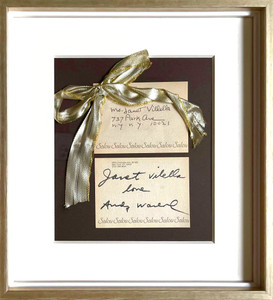
Description
Andy Warhol
YOU'RE IN , 1967
From the Andy Warhol Museum Website:
For Warhol, popular mass-produced food items represented the best and brightest of American consumerist society. What could be better than a product, be it Campbell’s Soup or Coca-Cola, which was distributed in vast quantities worldwide, the quality of which was consistently excellent and the price eminently affordable? Although he had made paintings of Coke bottles two years before, the artist now turned to a sculptural intervention using actual soda pop bottles (originally conceived by the renowned designer Raymond Loewy), which he coated with silver paint. Three years later, Warhol went a step further by capping 100 silver bottles and filling them with a perfume which he rakishly labeled “You’re In”/“Eau d’Andy.” Not surprisingly, the Coca-Cola Company responded with a cease and desist letter."
ANDY WARHOL QUOTE
“What’s great about this country is that America started the tradition where the richest consumers buy essentially the same things as the poorest. You can be watching TV and see Coca-Cola, and you can know that the President drinks Cokes, Liz Taylor drinks Cokes, and just think, you can drink Coke, too. A Coke is a Coke and no amount of money can get you a better Coke than the one the bum on the corner is drinking. All the Cokes are the same and all the Cokes are good. Liz Taylor knows it, the President knows it, the bum knows it, and you know it.”
- Andy Warhol, The Philosophy of Andy Warhol: From A to B and Back Again
Standing firmly alongside the iconic Campbell's Soup Cans and portraits of Marilyn Monroe, Andy Warhol's representation of the Coca-Cola bottle is one of a pantheon of images celebrating commonplace consumer products. "You're In" is part of a collection of silver spray-painted objects that was first seen on an exhibition poster for the Museum of Merchandise, advertising that the Coca-Cola bottles were filled with toilet water. In actuality, the shiny bottles were filled with a cheaply scented cologne called "Silver Lining," encapsulating the artist's incomparable ability to simultaneously destroy and retain the commercial identity of a mass-produced object. A few examples of You're In have come to auction over the years, fetching nearly $100,000 in recent years.
This particular work no longer has the cap with Warhol's initials; the smelly perfume is also long gone from all of them! However it is date stamped 1967 [ 13F67 on the underside] and has superb provenance, as it came from the Estate of Dr. Arthur C. Carr, a personal friend and collector of Warhol. Dr. Carr of Columbia University was one of the early collectors of Pop Art in the 1960s, and he befriended many of the artists whose work he collected.
Minor rubbing and fading to paint; no chips.
Numbered on base 13F67
Provenance: The Estate of Dr. Arthur C. Carr, New York City
Exhibited:
Long Beach, University Art Museum, California State University, The Great American Pop Store: Multiples of the Sixties, August 26 - October 27, 1997, then traveled to Zimmerli Art Museum (November 22, 1997 - February 28, 1998), Baltimore Museum of Art (March 25 - May 31 1998), Montgomery Museum of Art (June 27 - August 23, 1998), Weisman Art Museum (September 18 - December 13, 1998), McNay Art Museum (January 18 - March 14, 1999) Josyln Museum of Art (October 23 - January 9, 2000), Lowe Art Museum (February 3 - March 26, 2000), Toldeo Museum of Art (June 4 - August 13, 2000) (another example exhibited)
Literature:
J. O'Connor and B. Liu, Unseen Warhol, Cologne: Taschen, 1996, p. 120 (another example illustrated)
G. Frei and N. Printz, eds., The Andy Warhol Catalogue Raisonné of Paintings and Sculptures 1964-1969, vol. 2B, London: Phaidon, 2004, cat no. 1937.12, p. 287 (another example illustrated)
D. Hickey, Andy Warhol "Giant" Size, London: Phaidon, 2006, p. 135 (another example illustrated)
Catalogue Essay
“ You can be watching TV and see Coca-Cola, and you can know that the President drinks Cokes, Liz Taylor drinks Cokes, and just think, you can drink Coke, too.” - ANDY WARHOL
Warhol’s fascination with the metalizing of everyday objects began in 1967 with a prize he created for a contest sponsored by the Sunday Magazine of the New York-World
Journal Tribune. The prize was a silvered bomb.The contest winner recalled visiting the Warhol Factory and being disheartened that his prize was not one of the iconic commercial objects.Warhol famously stated: “It’s so beautiful I couldn’t ruin it by painting anything on it once I painted it silver. I’ve sat and stared at it for weeks.
Isn’t it beautiful?” (G. Frei and N. Printz,TheAndy Warhol Catalogue Raisonné Vol. 2B: Paintings and Sculpture 1964-1969,Phaidon, 2002, p. 279).
Warhol’s next collection of silver spray painted objects, done in the same year as the bomb, were his Coca-Cola bottles,which made their visual premiere on the poster for the Museum of Merchandise for an exhibition produced by The Fine Arts Committee of the Philadelphia YMHA and arranged by Joan Kron and Audrey Sabol. The poster advertised Warhol’s Coca-Cola bottles as being filled with toilet water and mischievously entitled “You’re in.” The outwardly shiny and slick bottles were, however, actually
filled with “Silver Lining,” an inexpensive cologne. By suggesting that this Coke bottle was filled with urine that had a cheap scent, Warhol seemed to defame the product that all Americas shared.Coca-Cola, however, was not amused and demanded that their production and sale be halted. This work encapsulates Warhol’s profound and unparalleled ability to both retain and destroy the commercial identity of the everyday object.






